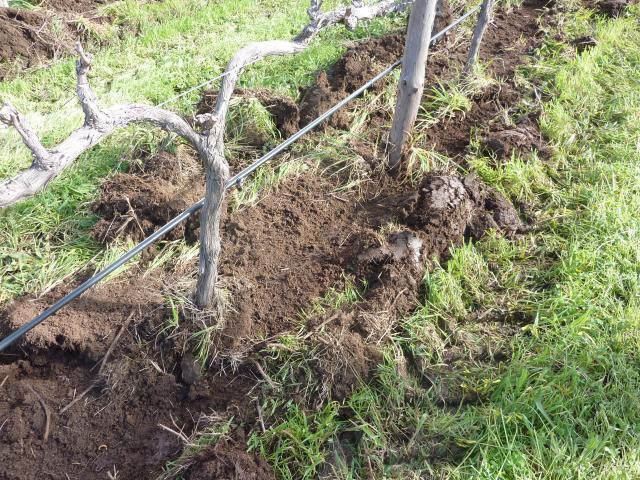Managing garden weevil in vineyards

Garden weevil remains an important pest in WA viticulture, more so because reliable alternatives to the use of synthetic insecticides remain a challenge. This is largely also the case for control methods acceptable for organic viticulture.
Reliance on synthetic insecticides increases the risk of resistance, but as yet no substantiated insecticide control failures have occurred.
There is also concern in the industry that the use of broad spectrum synthetic insecticides results in secondary pest outbreaks, though this also requires substantiation.
With respect to insecticides for control of garden weevil, Voliam Targo® has been registered relatively recently for us against mites and moth pests in grapevines and claims suppression, but not control, of garden weevil.
It contains the active ingredients abamectin, which controls active mites, and chlorantraniliprole, which is active against moth larvae and had some level of activity against garden weevil.
If moths in a particular area are a problem during the weevil emergence period in Spring, use of this product may offer some advantage in reducing weevil numbers at the same time.
The insecticide with activity against garden weevil is in a different activity group compared to indoxacarb (Avatar®) in terms of resistance.
Over the last two seasons, groups of vignerons in the Great Southern and Margaret River regions have been involved with examining alternative approaches to managing garden weevil (GW) in vineyards.
The range of approaches that were proposed for implementation are listed in the table:
| Treatment | Comments | Method |
| Soil health | Healthy plant may be more tolerant of GW feeding by adults & possibly larvae. | Products cultivated into soil pre bud burst and/or applied to foliage. |
| Contains one species of beneficial fungi to assess for control of soil borne larvae. | Incorporate into soil in early September and possibly follow up two weeks later. Check larvae for infection. | |
| Contains three species of beneficial fungi to assess for control of soil borne larvae. | Incorporate into soil in early September and possibly follow up two weeks later. Check larvae for infection. | |
| Cultivation | Aim to kill late stage larvae & pupae. | Cultivate dripline and/or inter-row. |
| Dacron™ bands | Preventative to keep adults out of the vine canopy. | Apply before adult weevil emergence as:
|
| Sticky band (polybutene) | Repels adult GW. Not practical – a messy treatment; time consuming to apply; compromised by trash rendering bands ineffective. | Trunk band applied before adult emergence. May be suitable for newly planted vines in GW infested sites. |
| Potassium silicate | Improves plant health, cell strength. | Foliar application up to three times after adult weevil emergence. |
| Chemicals | Insecticides Avatar® or Sumi-alpha Flex® to the canopy used as a comparison with alternative treatments. | Applied against adults up to the withholding period of berries pea size. |
| Refined clay eg Surround®, applied to trunks or foliage | Application to trunks may irritate adults and prevent them climbing. Application to foliage may interfere with adult feeding. | Apply after early signs of moderate weevil activity, most likely after flowering. Top with two later applications at half the initial rate. Mix separately with water before adding to the spray tank. |
In some of the vineyards, synthetic chemicals were applied as the standard commercial treatment. The methods assessed by vignerons were Mycoforce™, cultivation, dacron bands and Surround®.
Of these treatments, some level of control was achieved from cultivation where this was undertaken along the area about 30cm each side of the vine trunk.
Dacron™ bands, without supplementary treatment, had the effect of delaying weevil entry into the canopy, which did not prevent damage.
Other comments were that Myco-Force™ did not appear to reduce the abundance of adult weevils in the canopy.
For Surround® there were problems in mixing at the concentration required – two applications at half strength were necessary in order to physically apply this material at the required total rate.
Other general comments related to monitoring for weevil larvae to clarify their abundance and stage of development.
It was found that the distribution of larval food plants such as capeweed and plantain was directly related to locating larvae and pupae.
A new synthetic fibre is to be tested this coming season for comparison with the Dacron™ trunk band. This new fibre is microfine and offers superior trapping potential for garden weevil adults. Results of this testing will be reported by the investigator.
Research has been going on in the Cape Province of South Africa on the use of insect active parasitic nematodes. Good levels of efficacy have been reported from pot trials. More recent field trials are yet to be reported.
More research is required on this pest and we will consider whether we can contribute with any new approaches.
In the meantime, we are happy to discuss and assist vignerons in designing methodologies to rigorously test/investigate any management approaches being considering.
For further information contact Stewart Learmonth, Senior Research Officer on +61 (0)8 9777 0167 or Alison Mathews, Development Officer on +61 (0)8 9777 0122.
